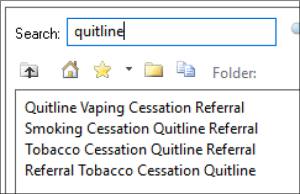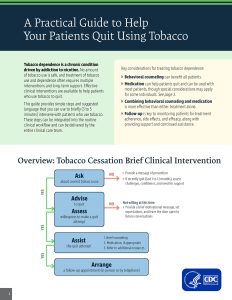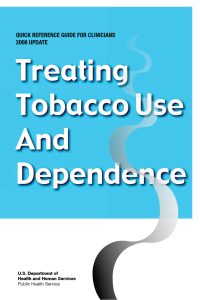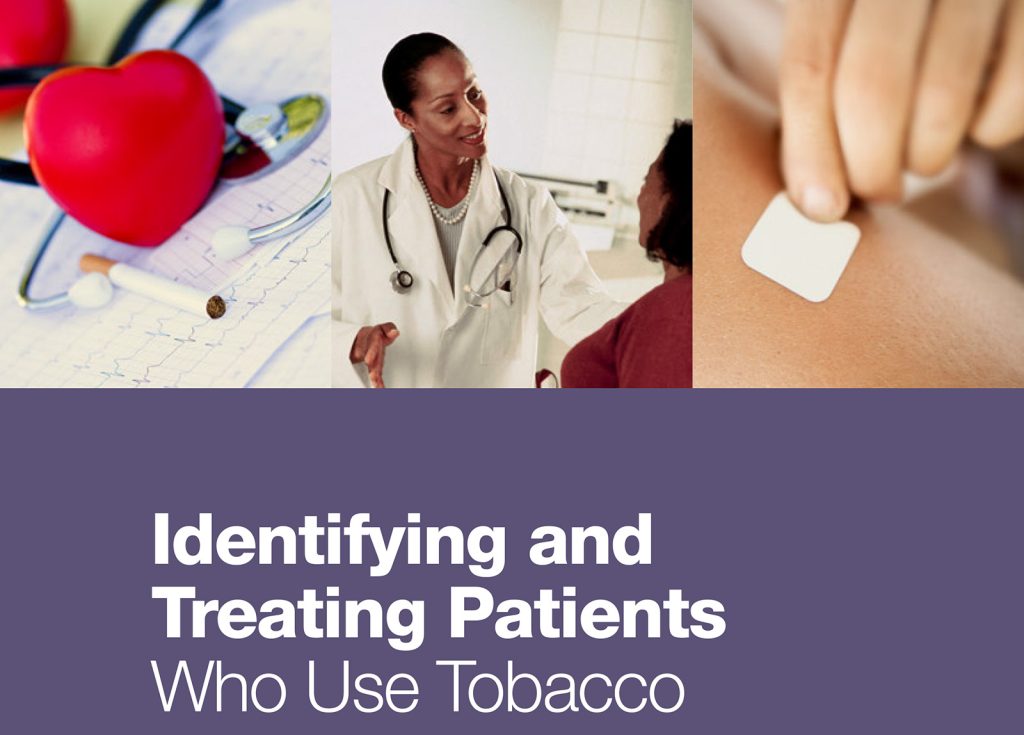Help your patients quit! Learn about cessation resources, medications, billing, and provider training available through Penn State Health and other organizations.
Understanding Tobacco Use Treatment Models
The 5 As brief intervention model is a simple framework to ask about tobacco use and offer help to quit. Yet implementation of all five As is inconsistent, with fewer providers assisting with quit attempts and arranging follow-up. Other models have streamlined the 5As to three steps. Ask-Advise-Refer guides providers to assess tobacco use, advise patients to quit, and refer them to cessation resources such as quitlines. Ask-Advise-Connect focuses on connecting patients directly to cessation resources through a link in the EHR.
The 5 As
to help patients quit
Ask about tobacco use
Advise to quit
Assess readiness to quit
Assist in the quit attempt
Arrange follow-up
Ask-Advise-Refer
to help patients quit
Ask about tobacco use
Advise to quit
Refer to outside help
Ask-Advise-Connect
to help patients quit
Ask about tobacco use
Advise to quit
Connect to Resources
From CDC’s Best Practices User Guides-Cessation in Tobacco Prevention and Control, 2021
Jump to topic
Search
Resources to Help Patients Quit Smoking or Vaping
PA Quitline

Cerner has a built-in Quitline referral order which will notify Quitline to call the patient.
- Cerner Quitline Referral Order: Tobacco Cessation Quitline Referral. Instructions for using the order are available on the Infonet (Penn State Health ePass login required). This will notify Quitline to call the patient.
- Providers can also make a referral on behalf of a patient via the PA Quitline website referral page.
- Self-Referral: Patients can be given Quitline information either as a flyer or on discharge instructions.
Refer to the patient resources page for phone numbers.
Note: If you make a referral on behalf of a patient, please make sure they know to answer the phone when they get a call from Quitline.
About Quitline
- PA Quitline offers 24/7 services in English and Spanish as well as text, chat, email and online support.
- PA Quitline will provide up to five free coaching calls to help formulate a quit plan and free nicotine replacement therapy (NRT) for those medically eligible. Its website can be used to help formulate a quit plan. Text or email support will send you motivational, informational, coaching messages.
- Reports a 37% responder quit rate for those using coaching + NRT
- Pregnant patients eligible for additional coaching, NRT and financial incentives
- Special programs for youths (tobacco and vaping) and Native Americans
- Free literature you can request and distribute to patients
Asian Smokers Quitline
The Asian Smokers Quitline provides tobacco cessation counseling and NRT in Cantonese, Mandarin, Vietnamese, and Korean. They also have a host of free literature in traditional and simplified Chinese as well as Vietnamese and Korean.
Penn State Health Tobacco Cessation Overview
This slide deck was created to provide an overview as to the rationale for providing tobacco cessation, an introduction to assessing willingness to quit and motivational interviewing, and available resources. Originally presented as a 45 minute lecture, it provides a great starting point to helping your patients quit smoking or other tobacco products. Download the presentation here (PowerPoint download via Sharepoint).
A Practical Guide to Help Your Patients Quit Using Tobacco (CDC)
This four-page guide is full of visuals providing a brief overview of how to screen patients for tobacco use and to provide a brief intervention. Geared towards providers and clinic leaders. Download it from the CDC website.
You Can Help Your Patients Quit Tobacco Use
This two-page document provides the rationale for tobacco cessation, links to many clinician training resources, current USPHTF recommendations and multilingual quit lines. Download it from the CDC website.
University of Wisconsin Center for Tobacco Research and Intervention
The UW Center for Tobacco Research and Intervention has an excellent series of short videos demonstrating how to utilize motivational interviewing and the brief tobacco cessation intervention to help patients quit smoking. They also have a great section for clinicians that provides information on medication dosing, billing for cessation activities, implementing systems change, and e-cigarettes.
Identifying and Treating Patients Who Use Tobacco: ACTION STEPS for Clinicians (HHS)
This 13-page comprehensive guide (PDF format via hhs.org) covers how to establish a tobacco screening intervention, assess willingness to quit, provide motivational interviewing and manage medication.
UCSF’s Rx for Change
UCSF’s Rx for Change program includes a variety of specialty specific (cardiology, psychiatry, surgical care, respiratory care) online modules that include both self-directed PowerPoint presentations as well as virtual patient exercises. The website allows for free registration and use of materials. It also includes patient friendly literature on topics including formulating a quit plan, medication information and full clinic tobacco cessation implementation toolkits.
Association for Treatment of Tobacco Use and Dependence
The Association for Treatment of Tobacco Use and Dependence has a number of provider resources including current research, billing and coding guidelines, and patient-centered resources.
Treating Tobacco Use and Dependence: 2008 Update
The Treating Tobacco Use and Dependence: 2008 Update Quick Reference Guide for Clinicians is a quick overview of current cessation recommendations, techniques for screening and motivational interview, medication dosing, and program implementation.
The full Treating Tobacco Use and Dependence: 2008 Update is available as well as a shorter summary.
(Public Health Service, 2008)
Additional resources
For more resources regarding implementing tobacco cessation interventions, health systems change, or primary literature, please see the Clinic Resources page.
Websites to Help Patients Quit
View more information on the patient resources page. These sites provide patient-friendly medication information sheets, quit plan generators, resources and a variety of tools patients can use to sustain their attempt.
Centers for Disease Control and Prevention Clinic Cessation Tools
This website provides a variety of resources for providers including reference guides, USPHTF recommendations, patient information, systems change tools, clinic screening protocols, electronic cigarette information and more.
Youth Smoking and Vaping: Websites For Parents
The My Life, My Quit Youth Tobacco and Vaping Cessation program has a website designed for parents with information on youth vaping and how they can talk to their teens about smoking/vaping and help them quit. The website has resources for parents in English and Spanish.
Sample Dosing Taper
New York City has a convenient medication dosing chart that includes contraindications, patient instructions and side effects for the seven FDA-approved medications and combination nicotine replacement therapy. View the resources on this page under Healthcare Professionals.
UCSF’s Rx for Change
UCSF’s Rx for Change has an easy-to-follow template of dosing based on the patient’s current tobacco use. They also have patient-friendly handouts on the seven FDA-approved medications for tobacco cessation, a relapse protocol, implementation guidelines and more.
University of Wisconsin Center for Tobacco Research and Intervention
The UW Center for Tobacco Research and Intervention has a section on medication dosing and patient-friendly medication handouts, among many other great resources.
Helping Smokers Quit – A Guide for Clinicians: PHS Clinical Practice Guideline Treating Tobacco Use and Dependence: 2008 Update
This short guide (PDF format) offers a brief introduction to the 5As as well as an easy to read medication dosing chart covering the seven FDA-approved tobacco cessation medications. View more information in non-PDF format here.
(Public Health Service, 2008)
Identifying and Treating Patients Who Use Tobacco: ACTION STEPS for Clinicians (HHS)
Identifying and Treating Patients Who Use Tobacco: ACTION STEPS for Clinicians (PDF format via hhs.org) is a 13-page comprehensive guide that includes information on cessation medications and dosing.
Overview
Documentation of smoking status and willingness to quit is important for patient care, particularly when patients are transitioning in and out of the hospital, so progress made is not lost. Ideally, willingness to quit, and cessation counseling or medications utilized should be documented in the following places:
- Problem List
- Hospital Course
- Discharge Instructions
Sample documentation and billing autotext is available here [Word document download].
Billing for Tobacco Cessation Counseling
If cessation counseling by a provider lasts at least 3 minutes and is documented correctly, it is billable at the rates below.
CPT 99406: 3-10 minutes – 0.35 RVUs ($11.57)*
CPT 99407: >10 minutes – 0.74 RVUs ($24.47)*
*Updated 2023; Total National facility RVUs
Billing Templates
Templates are available at the link above, or you can design your own using the resources below. There are also instructions from Penn State Health on billing and coding.
Billing Guide for Tobacco Screening and Cessation
(American Lung Association, 2021)
This 16-page guide is a quick read and provides a comprehensive overview regarding billing and documentation requirements for cessation activities, including common reasons for claims denials. It is especially helpful when designing an autotext for tobacco cessation that will meet all the billing requirements. Find the guide at Lung.org under Billing, Coding and Payment.
University of Wisconsin Center for Tobacco Research and Intervention
The UW Center for Tobacco Research and Intervention has a section on how to bill for cessation activities among many other great resources.
Protocol for Identifying and Treating Patients Who Use Tobacco (HHS)
The Protocol for Identifying and Treating Patients Who Use Tobacco is a fillable template for implementing tobacco use screening and includes applicable billing codes.
The Penn State Tobacco Cessation Inpatient Consult Service is currently not in operation at Penn State Health Milton S. Hershey Medical Center. Orders for tobacco cessation consults and ED cessation consults are not monitored and a provider will not respond to counsel your patient. Providers should utilize the Cerner Quitline Referral or counsel the patient themselves.
Penn State Health Tobacco Cessation Clinic
Penn State Health has a designated tobacco cessation clinic within Penn State Cancer Institute that will provide both counseling and medication management. No referral is required (although providers can refer patients). Most health insurance will cover two quit attempts per year each consisting of up to four visits.
Penn State Cancer Institute Care Center Tobacco Cessation

Creating a provider order for PSHCI CARE Center in Powerchart

Referring a patient to CARE Center using E-Messaging.
Patients with an active cancer diagnosis may be eligible for tobacco cessation through the Penn State Cancer Institute Care Center. Patients can be referred from any Cancer Institute disease teams. Referrals can be made by calling the CARE Center at 717-531-0003, x285186, via e-message to PSHCI CARE CENTER pool, or CARE Center order in PowerChart.
Penn State Health Primary Care Providers
Penn State Health Primary Care Providers are trained to help you stop smoking and can prescribe tobacco cessation medications when medically appropriate. Follow this link to find a doctor within the Penn State Health System.
Penn State Health employees
Penn State Health employees can take advantage of the Employee Tobacco Intervention Program. This free program can be accessed through employee health.
Penn State students
Penn State University students can access the free Freshstart® Program through University Health Services.
Click here for a list of active Penn State Center for Research on Tobacco and Health clinical trials that patients may be eligible to participate in investigating nicotine, smoking and health. Studies may be available both for patients interested in quitting smoking and those who are not yet ready to quit.
Penn State Health Literature
The Penn State Health Print Shop has Penn State branded pamphlets that can be distributed to patients. The Penn State Health Tobacco Cessation Brochure helps patients to list reasons why they want to quit and identify their support system. It also includes tips for creating a quit plan, managing cravings, and where patients can seek help. It is designed to be distributed to patients or guide a brief tobacco cessation intervention during an office visit. Ordering can be done via the Infonet (Penn State Health ePass login required).
PA Quitline
PA Quitline has a number of free pamphlets, postcards, rack cards, flyers, business cards, and posters available for clinics to order and distribute to patients that can be shipped to clinics at no cost. They also offer literature in many languages, including both Spanish and Nepali (among many others).
Asian Smokers Quitline
The Asian Smokers Quitline has a host of free literature, posters and flyers in traditional and simplified Chinese as well as Vietnamese and Korean. This organization is separate from PA Quitline and will provide many of the same services in Mandarin, Cantonese, Vietnamese or Korean for non-English or Spanish-speaking patients.
University of Wisconsin Center for Tobacco Research and Intervention
The University of Wisconsin Center for Tobacco Research and Intervention has excellent information for those interested in quitting smoking or stopping e-cigarettes and covers the 7 FDA approved medications for smoking cessation, including how they work and common side effects.
Agency for Healthcare Research and Quality Worksheets
These worksheets are designed to be filled out with patients to quickly help them identify barriers to and resources they can utilize to help them quit.
In addition to the standard version, a version is specifically for expecting mothers. Versions en español of the standard and expecting mother worksheet are available.
The Agency for Healthcare Research and Quality Worksheets also has a hospital tobacco cessation poster (PDF download).
University of California San Francisco’s (UCSF) Rx for Change
UCSF’s Rx for Change program includes a variety of specialty specific (cardiology, psychiatry, surgical care, respiratory care) online modules that include both self-directed slideshows as well as virtual patient exercises. The website allows for free registration and use of materials. It also includes patient friendly literature on topics including formulating a quit plan, medication information, and full clinic tobacco cessation implementation toolkits.
My Life, My Quit
The My Life, My Quit Youth Tobacco and Vaping Cessation program has free brochures and posters you can print yourself on their website or you can request printed versions from PA Quitline to be mailed to you for free using the email address in the PA Quitline tab. They also have a marketing/media toolkit available by emailing healthinitiatives@njhealth.org.



